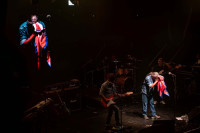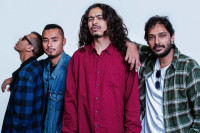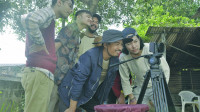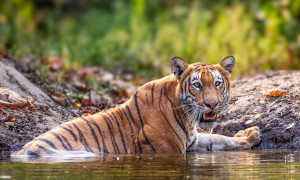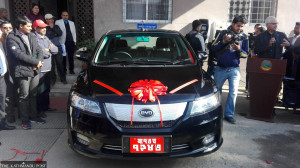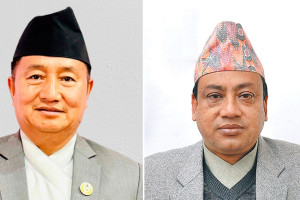Entertainment
The evolution of the author
The violin lessons that Rohit Shakya took at an early age steered him onto the path of music.
You’re a gifted singer-songwriter. You also play a number of instruments, make electronic music, take photos and shoot videos. Out of all these personas, which one do you associate with the most?
I will always portray myself as a musician first because music has always been my true calling. I started making videos to merely complement the music I was making, but it soon turned into a promising career, which is not so bad when I come to think of it. So, whatever form of art I practice, it will always be directly or indirectly associated with music.
We heard you were introduced to music quite early in your life.
My formal music education began when I was in the 4th grade, when I started taking violin lessons. I stuck with that for a few years before I became interested in playing the guitar. But they didn’t give guitar lessons where I took classes, so I had to make do with my old fiddle, playing Voodoo Chile on it like it was an electric guitar. Once I got my first guitar a few years later, I never went back to the violin, although I’ve come to regret that decision. Anyways, one thing led to another, and I eventually ended up producing music. A few years ago, I got a Diploma in Audio Engineering from the SAE Institute, Bangkok. I’ve been working as a professional music producer ever since.
Talk us through your days as a performer at live rock gigs.
I still remember my first underground gig. It was a KTM Rocks concert named Metal Pollution, at Mahendra Police Club. I used to play in a band named Screech back then, with Bibhushan Basnet, Abhisek Bhadra and Prakrit Shrestha, who also played in other bands like Breeding Pestilence and Atomic Bush. We had hired a Safa Tempo to the venue, which was quite something. After Screech, I played for Holocaust, Knives and Plebeian, but I always felt the need to contribute something substantial to music. So I convinced my friends to form a new rock band and together we came up with Jindabaad.
Tell us about Jindabaad. What can Jindabaad fans expect in the near future?
Jindabaad has definitely been the biggest highlight of my career. Not only have I gotten the opportunity to explore myself as a singer and a guitarist but I have also learned the ins and outs of album production, which involves recording, mixing and mastering albums. Jindabaad was formed as a collective of like-minded individuals, for us to share and explore our musical ideas through experimentation. We believe that rock music should not be confined to the conventional sound or just one style. Sometime after our album was released, we wanted to explore other stuff and decided to take a brief unofficial hiatus. We have all been growing musically, and it won’t be too long before we hit the studio to work together on our new ideas.
What are you up to these days?
I’m currently working on some music video projects and multimedia pieces for Fuzz Factory Productions. But I’ve also been experimenting with ambient electronic bass music for my solo debut album.
How are you associated with Fuzz Factory Productions?
I’m the cofounder of Fuzz Factory Productions. We’re a multimedia company that produces music videos and documentaries. I usually work as a director/producer and an editor but I don’t mind working on cinematography for a change.
What kinds of projects do you usually undertake at Fuzz Factory? Anything interesting lately?
Although we specialise in making music videos, we are diversifying into short films and documentary production. We recently had an amazing experience producing the video for Arogya, a Sikkim-based band. Because the Underside videos we’d worked on earlier has been well-received, there is a lot of buzz and we’re getting offers from some Indian bands as well. Nothing has been finalised yet, but this is definitely good news for us.
Lately, we have been busy on a new Underside video, which will be darker and scarier than the previous two.
Tell us how you came to be The Author.
Originally, I identified with rock and roll, but I’ve always had a thing for electronic music. Ever since I got the hang of producing digital music, I’ve been immersed in electronic music. When I wanted to put together an electronica album, I decided to take on a different moniker. So I came up with the name The Author.
What is your approach to making electronic music?
My electronic music falls under the Chill, Future Bass, IDM genre, but I’m always looking to fuse eastern elements and instrumentations. I believe in the idea that music is universal, but the roots of any music definitely shape the final sound. I know Nepal doesn’t have a vibrant electronic scene at the moment, but I want my attempts at making electronic music to go a long way into creating a base for this genre. Right now, I haven’t released or promoted my tracks because I want to come out with a proper sound and apt music videos for them.
How long do you think before Nepali music industry embraces The Author kind of music?
I don’t see it happening anytime soon. Even if Electronic Dance Music (EDM) becomes popular here, it is going to be a big challenge for the kind of electronic music I produce, which is an alternative subgenre within the electronic genre. When the entire industry is saturated and barely making any progress, it’s rather difficult for new music or videos to break through.
What is it that you have been seeking from your music?
It’s the self-gratification, I think.
A few words of advice for aspiring musicians.
Four words: experiment, learn, share and enjoy.




 28.53°C Kathmandu
28.53°C Kathmandu

